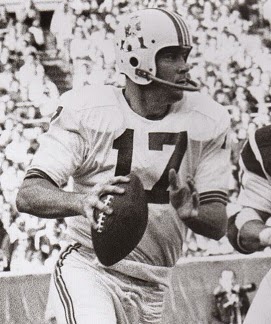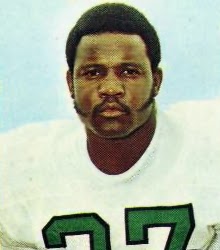The Cleveland Browns were 3-2, having lost the previous
week against Green Bay, as they took on the Pittsburgh Steelers on October 22,
1961. Head Coach Paul Brown’s team had an outstanding rushing tandem with FB
Jim Brown and HB Bobby Mitchell operating behind a solid line, but the pass
receivers were less impressive and now QB Milt Plum was out with a dislocated
right thumb suffered against the Packers. Len Dawson, still yet to emerge in
his fifth year after having been drafted by the Steelers in the first round out
of Purdue in 1957, was starting in his place.
Pittsburgh, under Head Coach Buddy Parker, was 1-4 and
had showed a tendency for losing close contests. QB Bobby Layne was out with a
shoulder injury and Rudy Bukich, a 29-year-old career backup, was filling in.
Split end Buddy Dial was a fine deep threat FB John Henry Johnson led the
ground game, but age, combined with a big turnover in personnel, was a problem
for the Steelers on both sides of the ball.
There were 29,266 fans in attendance at Forbes Field. The
Steelers had first possession and punted, but got the ball back when CB Johnny
Sample intercepted Len Dawson’s third pass. Rudy Bukich threw to Buddy Dial for
19 yards but, after advancing to the Cleveland 36, the home team came up empty
when Lou Michaels was short and low on a 44-yard field goal attempt.
On Cleveland’s next series, Bobby Mitchell ran to his
right and down the sideline for a 48-yard gain to the Pittsburgh 16. Two
carries by HB Tom Watkins picked up six yards, but Dawson was then sacked by DT
Gene “Big Daddy” Lipscomb and Lou Groza kicked a 24-yard field goal to make it
3-0.
The Steelers punted following a short series and, in a
drive that extended into the second quarter, the Browns advanced deep into
Pittsburgh territory. Jim Brown ran four consecutive times for 22 yards to
start things off and Mitchell converted a fourth-and-one play with a two-yard
carry. However, after Brown took a pitchout and ran 20 yards to the Pittsburgh
one yard line, the great fullback fumbled while attempting to hurdle the line
and safety Jackie Simpson caught the ball in the air in the end zone and
returned it to the nine.
The Steelers again had to punt and the Browns, taking
possession at their 49, went 51 yards in seven plays, this time not coming up
empty. Brown and Mitchell ran effectively and Dawson completed a pass to
Mitchell for nine yards. Mitchell gained the last six yards for a touchdown
and, with Groza’s extra point, the visitors were in front by 10-0. That
remained the score at halftime as the teams traded punts for the remainder of
the half.
The frustrated home fans booed the Steelers as they
returned to the field for the second half. The Browns edged into Pittsburgh
territory on the first series of the third quarter, but a Dawson pass was
picked off by CB Bill Butler and he returned it to the Cleveland 42. Now the
Steelers moved effectively with John Henry Johnson and HB Tom Tracy running
well. Bukich threw to Dial for a 12-yard touchdown and, adding Michaels’ PAT,
which hit the crossbar but made it over, the Cleveland lead was cut to 10-7.
A short possession by the Browns was followed by a punt
and, after no gain on a first down running play, Bukich connected with Dial on
three straight passes for 17, 33, and 10 yards to reach the Cleveland 13. HB
Dick Hoak ran twice for eight yards and, on third-and-two, Dial came through
with a leaping catch that picked up three yards. On the next play, Tracy ran
for a two-yard TD between the goal posts and, with Michaels successfully
converting, the Steelers were ahead by 14-10.
Milt Plum was at quarterback for the next Cleveland
series, and he threw to ends Leon Clarke for 23 yards and Rich Kreitling for 10
to get to the Pittsburgh 35. The drive stalled at the 29 and Groza kicked a
36-yard field goal to make it a one-point contest.
On the last play of the period, safety Bobby Franklin
intercepted a Bukich pass and the Browns, taking over at the Pittsburgh 25,
drove to a score in five plays. Plum had a pass to Mitchell for 11 yards along
the way and it was Mitchell running the last nine yards for a touchdown. Groza
added the extra point and Cleveland was back in the lead by 20-14.
The Steelers had to punt on their next series, but got
the ball back at the Cleveland 24 when Mitchell fumbled a pitchout and DT Joe
Krupa recovered. Tracy was stopped for a four-yard loss on the next play, but
Bukich connected with Dial for 24 yards and Tracy gained the last yard for a
TD. Michaels converted to put the home team back on top by 21-20.
The Browns came back with a six-play, 72-yard drive. Plum
completed a pass to TE Gern Nagler for 18 yards and another to Mitchell, also
for 18, and after Mitchell ran for 14 yards, he sped around end for an 18-yard
touchdown. Groza kicked the point after and the see-saw battle had Cleveland
back in front by 27-21.
On Pittsburgh’s first play from scrimmage following the
kickoff, Bukich tossed a screen pass to Johnson who fumbled after running into
his own man and DE Paul Wiggin recovered for the Browns at the 10. The Steelers
were able to keep the visitors out of the end zone, but Groza kicked a 12-yard
field goal to make the score 30-21 with less than three minutes remaining to
play.
Pittsburgh, starting at its own six after the kickoff,
responded with a big play two snaps later as Bukich connected with Dial for an 88-yard
touchdown. Michaels kicked the PAT to make it a two-point game, but by the time
the Steelers got the ball back again, the clock was down to 45 seconds and the
game ended for them on their 32 yard line. Cleveland came away with a 30-28
win.
The Browns had the edge in total yards (378 to 309) and
first downs (21 to 17), with 229 of their total coming on the ground. They also
turned the ball over four times, to three suffered by Pittsburgh, but recorded
six sacks, to one by the Steelers.
Both Bobby Mitchell and Jim Brown went over a hundred
yards rushing, with Mitchell compiling 119 yards on 14 carries that included
three touchdowns and Brown gaining 114 yards on 29 attempts. Mitchell also
caught four passes for 47 more yards to lead the Browns. Len Dawson completed 6
of 12 passes for 68 yards with no touchdowns and two interceptions before being
relieved by Milt Plum, who was 6-of-8 for 88 yards and, while also throwing for
no TDs, gave up no interceptions. Lou Groza was successful on all three of his
field goal attempts.
For the Steelers, Buddy Dial (pictured at right) had a huge performance in
defeat with 9 catches for 235 yards and two touchdowns. Rudy Bukich was
successful on 15 of 24 throws for 275 yards and two TDs with one interception.
John Henry Johnson rushed for 35 yards on 8 carries and Tom Tracy was right
behind with 34 yards on 12 attempts that included two for touchdowns.
The Browns won again the next week as they sought to keep
up with the Giants and Eagles in the Eastern Conference, but they ultimately
finished at 8-5-1 to settle for third place. Pittsburgh came back with a
three-game winning streak, including one over the Browns in the rematch in
Cleveland, and finished strong for a 6-8 record that ranked fifth in the
conference.
Bobby Mitchell was called up to active military duty but
was still able to get passes to play on the weekends and rushed for 548 yards
on 101 carries (5.4 avg.) and had 32 pass receptions for another 368 yards
(11.5 avg.), scoring a total of 10 touchdowns. Jim Brown, as he had in each of
the previous four seasons since entering the NFL, led the league in rushing
with 1408 yards on a then-record 305 carries (4.6 avg.) and received his annual
first-team All-NFL and Pro Bowl honors. Milt Plum topped the NFL in passing
efficiency for the second straight year, completing 58.6 percent of his throws
for 18 TDs against 10 interceptions.
As had been the case throughout his career to date, Len
Dawson saw scant action over the course of the season, throwing 15 passes - his highest total thus far. He moved over to the Dallas Texans of the AFL in 1962 and his fortunes
changed dramatically for the better.
In his third year, Buddy Dial gained selection to the Pro
Bowl after catching 53 passes for 1047 yards (19.8 avg.) and 12 touchdowns. His
235-yard pass receiving performance against the Browns remained the franchise
record until 2002. Rudy Bukich ultimately moved back to the bench with the
return of Bobby Layne, but won four of his seven starts and had a solid
completion percentage of 57.1 on his 156 passes. 11 were good for TDs, but he
also gave up 16 interceptions.



























